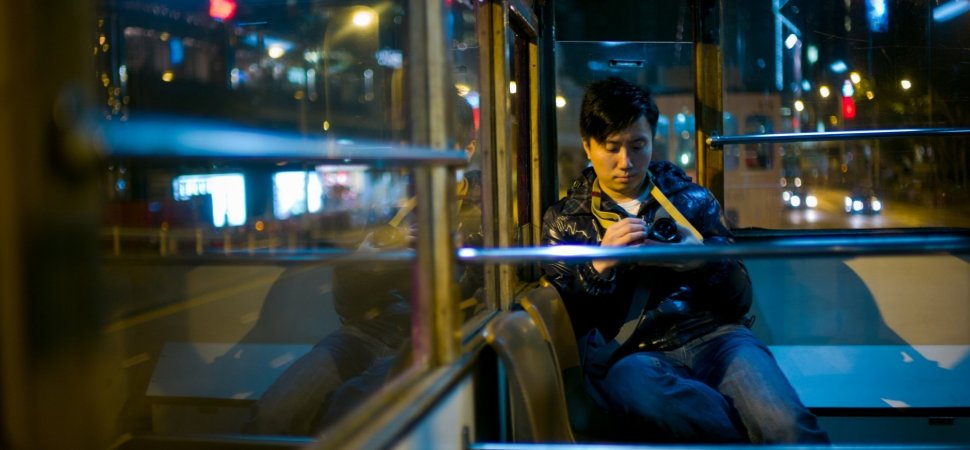
Move over, Hyperloop. The sleeper cabin is making a comeback.
A former Thiel fellow — one of the college kids who took $100,000 from venture capitalist Peter Thiel to drop out of school and pursue a life of entrepreneurship — is launching a company to compete with California’s chimerical high-speed rail and Elon Musk’s proposed 30-minute Hyperloop train.
It’s not much more than a hotel on wheels, but what the idea lacks in futuristic gee-whiz appeal, it makes up for with another advantage: As of last night, it’s already running.
“It would basically be like you teleported to L.A. It would be cool,” Tom Currier said recently of his overnight bus service, SleepBus. The first bus contracted into the fleet made its inaugural “teleportation” trip from San Francisco to Los Angeles last night. Eleven passengers paid $48 a piece to rent out bunks in the 20-bed Volvo sleeper coach. The bus left from the Caltrain station in San Francisco’s South of Market neighborhood at 11 p.m. and arrived at Santa Monica Pier a 6 a.m. Passengers slept until the 7:30 a.m. checkout.
The vehicle boasts a lounge area, free coffee and tea, free WiFi, and sheets frommattress startup Casper on its twin-sized cots. Service on SleepBus is direct, with no intermediary stops. It’s an economical alternative to plane travel, with tickets falling roughly in the $100-to-$200 range. And the bar for quality of long-distance transportation in the same price range of Sleepbus is notoriously low. It’s not hard to beat a $38 ticket for Greyhound’s overnight service. Greyhound’s overnight service between San Francisco and Los Angeles offers extra leg room but not beds. As long as SleepBus doesn’t catch on fire, it has a leg up on competitor Megabus, too.
When you consider the geographies SleepBus serves, the startup could be competitive as more than a bus. An overnight ride at $48 is cheaper than most bargain-rate hotel rooms and certainly less expensive than your standard Airbnb in a major city. The bus has no shower, so it’s not really fair to compare it to a living space, but would anyone familiar with rent prices in San Francisco and Los Angeles be shocked to learn of someone buying a month’s worth of tickets to live on the vehicle and bathing at the nearest YMCA?
You may be pardoned if you think SleepBus sounds like a classic Silicon Valley repackaging of a basic service under the guise of innovation. However cynically you look at it, interest is there — and more of it than Currier anticipated. Roughly one in 25 who see Facebook ads for Sleepbus are clicking through, and one ad received as many as 203,000 views, according to Currier. Customers are excited about the idea and they get it, he says. “I mean, SleepBus is pretty simple, right?”
In mid-March, within days of posting an initial ad to test interest, Currier said he received calls from potential customers asking if they could rent out entire buses, and some calls from folks just saying they thought the service was a good idea. One videographer asked about purchasing tickets for extra beds to send his equipment from one end of the state to the other, according to Currier. He realized he was onto something and hopped on the phone to contract a charter bus.
He predicts the nascent company will become a go-to for those commuting from NoCal to SoCal. He cites a data point from a PDF of ridership and revenue forecastsprojected for the planned high-speed rail under construction across the state. At 50 percent the cost of a plane ticket, a line between the Bay Area and Los Angeles could draw 10.8 million annual riders, according to the report. That’s the market, says Currier.
With trips now underway, 177 tickets for scheduled trips had sold as of early Tuesday morning, he confirmed. For buses that fill, he estimates revenue of about $1,500 per each load, over a cost of about $780 per run.
The San Francisco-based entrepreneur hasn’t yet raised any funding for the venture.
He and a pair of friends in the Bay Area, plus an additional pair of contractors in Los Angeles, are running the project on money Currier earned from past endeavors.
As a Thiel fellow, Currier served as a co-founder and CTO of solar energy tech startup
QBotix. Currier’s LinkedIn page says he departed from the company in 2012, and media reports say it shut down operations in September. Currier said at the pointof shutdown, QBotix intellectual property sold in a deal about which he could not disclose details.
After QBotix, the Stanford dropout co-founded Campus Coliving, a real estate startup that aimed to replicate the campus living environment for young adults. The company, referred to by Bay Area blog SFist as essentially a corporate co-op, was managing 30 properties of between five and 23 residents each in San Francisco and New York when it shut down in August. Currier says Campus was able to transfer leases to residents of roughly 25 of the houses.
SleepBus stems from the same bug as Campus Coliving for Currier — a desire to build communities. The bus service connects to his vision of building an entirely new city located hours outside of San Francisco. Kudavi, as he intends to call it, would ultimately be populated by around five million creative workers and remote employees including many with jobs that take place in virtual and augmented reality. “You don’t have to commute to the city, you can just, like, put on the HoloLens,” says Currier, referring to the not-yet-released augmented reality glasses from Microsoft.
Sounds lofty, and maybe a little eccentric, but “every city was created from nothing, right?” says Currier. (So, incidentally, is the name, a word Currier made up.) He said Kudavi would be founded with a more manageable population, maybe of about 50,000. With Alphabet subsidiary Sidewalk Labs reportedly building a smart city, the idea of city-as-entrepreneurial-venture doesn’t sound entirely outlandish.
In planning out his hypothetical city, Currier ran into the question of how people would get into San Francisco when the occasion arose. He realized residents would need buses. “And then I was talking with a friend and he was like, ‘Why don’t you just do that?'” SleepBus was born.
Currier isn’t giving up on Kudavi despite now focusing on SleepBus. He said in mid-March he thought it was a good idea to put Kudavi on hold while virtual reality technology gains traction. This tendency toward futurism extends to the bus company, where Currier hopes advances in certain technologies will allow for greater comfort. He’s excited about active suspension systems under development by Bose that he says will make ground transportation unimaginably smooth, and autonomous trucks that could make it economical for SleepBus to offer riders luxury private suites.
One SleepBus vehicle is slated to bounce between San Francisco and Los Angeles for the next two weeks, meaning riders in each city will have access to service every other night. At the end of the two-week trial, SleepBus plans to bring on an additional Volvo coach so service from each city can run daily. The company ultimately plans to retrofit double-decker Van Hool buses (the same type Google uses to ferry employees from around the Bay Area to headquarters) for a capacity of 28 to 32 beds per vehicle.



